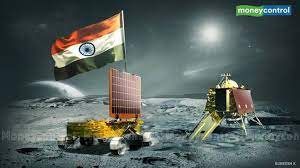
Chandrayaan-3's Successful Landing
Chandrayaan-3's Successful Landing
Mains Exam: General Studies Paper 3
(Science & Technology)
August 24, 2023
Why in News:
- India's Chandrayaan-3 successfully landed on the Moon's surface on August 23, 2023.
Main points:
- India has become the fourth country to successfully land on the surface of the Moon.
- India became the first country to touch the polar region of the Moon.
- The lander module of Chandrayaan-3, which houses the rover, touched the lunar surface on August 23, 2023 at exactly 6.03 pm.
- After the successful landing, there was an enthusiastic celebration at the Mission Operations Complex (MOX) at ISRO Telemetry, Tracking and Command Network (ISTRAC), Bengaluru.
- India has joined an elite list of countries including the United States, Russia and China.
- According to Mr. Somnath, the lander has achieved most of the landing conditions, including the touchdown speed. Lander's touchdown speed was less than 2 meters per second
- The lander is fully fit to carry out all the next planned experiments, including the Pragyan rover.
- According to ISRO's scientific team, we will now consider sending humans into space, sending spacecraft around Venus and landing on Mars.
Next step of Chandrayaan-3 mission:
- The lander will deploy a rover which will carry out in-situ chemical analysis of the lunar surface during its mobility.
- This Chandrayaan-3 carries lander and rover scientific payloads to conduct experiments on the lunar surface in one lunar day (equivalent to 14 Earth days).
- The Chandrayaan-3 mission was launched on July 14, 2023, from the Satish Dhawan Space Center in Sriharikota.
- Chandrayaan-3 comprises an indigenous lander module, a propulsion module and a rover, aimed at developing and demonstrating new technologies required for inter-planetary missions.
- The objective of the mission is to demonstrate a safe and soft landing on the lunar surface, perform locomotion of the rover on the Moon and conduct scientific experiments in situ.
- This soft landing comes days after Russia's Luna-25 spacecraft went out of control and crashed on the Moon.
- The four-legged lander has several sensors to ensure a safe touchdown, including an accelerometer, altimeter, Doppler velometer, inclinometer, touchdown sensor and a suite of cameras for hazard avoidance and situational awareness.
How useful is the Chandrayaan-3 Mission to Humanity:
- In 2008, India's first lunar mission 'Chandrayaan-1' was the first to find evidence of water on the moon while orbiting it. The Lunar Reconnaissance Orbiter of the US space agency NASA, which has been orbiting the Moon for almost 14 years, has also detected water ice in some of the permanently shadowed large craters (pits).
- Apart from this, the possibility of energy, minerals and metals being present there has been expressed by analyzing the material brought from the moon by the lunar missions of different countries. Experts believe that if human access to water or minerals and metals present on the moon is easy, then their use will prove to be very useful for humanity in the future.
Chandrayaan-3 will collect these Important Information:
- What is in the elemental composition of the Moon, What is the density of lunar surface plasma, What are its thermal properties (thermal properties), How is the movement (seismicity) below the surface there and what is special about the regolith (lunar crust), all these important things will be detected through Chandrayaan-3.
- For this, Pragyan Rover is equipped with two main instruments Induced Breakdown Spectroscope (LIBS) and Alpha Particle X-ray Spectrometer (APXS). LIBS will detect chemical elements and materials present on the lunar surface, including the discovery of elements such as magnesium, potassium, calcium, aluminum, silicon, titanium and iron. Apart from this, chemical compounds present in the soil and rocks of the lunar surface will be detected through APXS.
The team behind the success of Chandrayaan-3:
- Mr. Somnath- ISRO chief
- P. Veeramuthuvel - Project Director
- Srikanth - Mission Director
- Kalpana K. - Associate Project Director
- M. Sankaran - Director
- U.R. Rao-Satellite Center Head
Prime Minister's Message:
- After the successful landing, Prime Minister Narendra Modi while addressing the nation from South Africa said that India's successful Moon mission is based on a human-centred approach. Due to the dedication and talent of our scientists, India has reached the South Pole of the Moon, where no country in the world has been able to reach till date.
- Our vision of 'One Earth, One Family, One Future' is resonating across the globe. The human-centred approach we represent has been universally welcomed. The success of the lunar mission belongs to the entire humanity. And this will help in future lunar missions of other countries.
----------------------------------
Mains Exam Question
Recently Chandrayaan-3 has successfully landed on the surface of the Moon. In this context, discuss the next steps of Chandrayaan-3 and "what will be its usefulness to humanity".